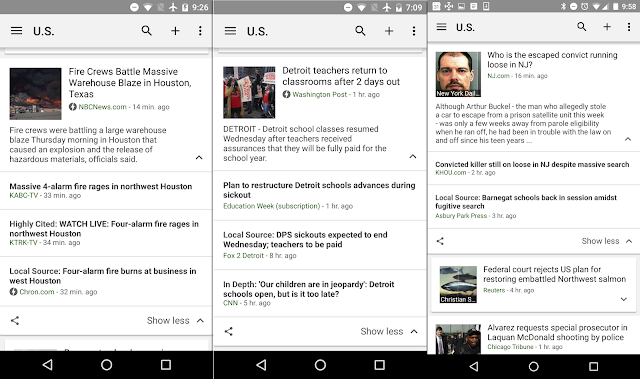Introducing Google News Lite mode — faster news for slower networks
We plan to bring Lite mode to users in Brazil and Indonesia later this year, and more places next year.
We plan to bring Lite mode to users in Brazil and Indonesia later this year, and more places next year.
Posted by James Morehead, Product Manager, Google News
TL;DR Google News has launched a “Local Source” Tag to surface local coverage of major stories.
Local news publishers play a critical role in covering the stories that impact us every day in our cities, schools and neighborhoods. Local reporters are often members of the communities they serve, bringing additional context and perspective to a story. Local news is also important to our users: according to the March 2015 Pew Research study Local News in a Digital Age, which looked at three metro areas across the U.S., “nearly nine-in-ten residents follow local news closely—and about half do so very closely”.
But not all local stories stay local. When a local story is picked up by national publishers, it can be difficult for local sources to be heard even after they’ve done the legwork and research to break a story. Consistent with our goal to surface diverse perspectives, we’re excited to share that a new “Local Source” tag is now live across all Google News editions. This new feature brings greater exposure for local news outlets reporting on stories that have gone national. “Local Source” articles are identified automatically by looking at where a publisher has written about in the past and comparing that to the story location. You’ll see the tagged articles in the expanded story box on news.google.com and in the Google News & Weather iOS and Android apps.

A great example of hyperlocal news is 9-year-old reporter Hilde Lysiak. Hilde made headlines when she reported on the story of a murder in her hometown which she published on her own local news site — Orange Street News (AMP-enabled to load really fast on mobile). Her reporting attracted the attention of major newspapers and morning shows like Good Morning America after she was criticised for being too young to cover hard news. It was one reason we invited Hilde to visit the Googleplex on World Press Freedom Day 2016. And just like Hilde, at Google News we are committed to connecting people to the news that matters most to them — be that local, national or international.
| 9-year-old Hilde Lysiak visited Google on World Press Freedom Day, May 3, 2016. |
At its heart, Google News is about keeping people up-to-date with what is going on in the world and providing news from diverse perspectives. But this goal is meaningless unless we get the reading experience right. For too many people, reading the news on their mobile devices can be slow and clunky, forcing them to abandon a site. That’s why we joined others across the industry on the Accelerated Mobile Pages Project (AMP for short) – an open source initiative to make the mobile web as fast as possible.
Our tests have shown that AMP documents load an average of four times faster and use 10 times less data than the equivalent non-amp’ed result. In many cases these stories will load instantly. That adds up to a win for publishers and users. While we can’t expand the amount of time in the day, with AMP we can help users consume more content in the time they do have. It is also great for publishers because people will read more and click on more stories when they know they will load fast, driving more traffic to a publisher’s site.
We’re starting AMPlification with our English US Edition – more languages and editions will be rolling out soon.